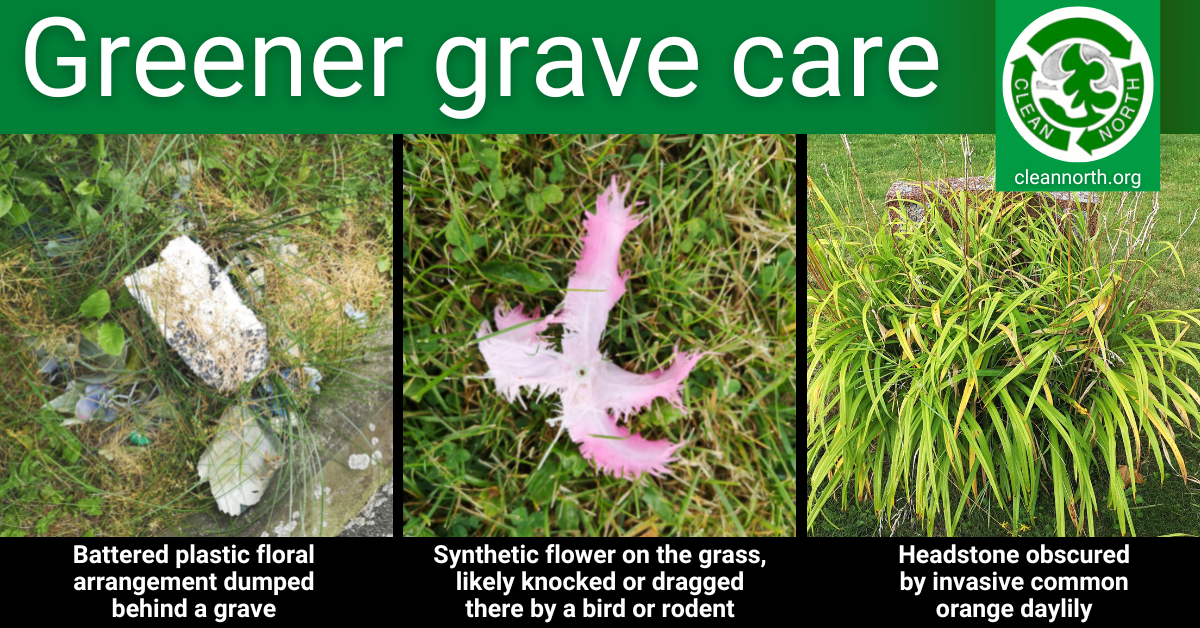
After a loved one has passed away, beautifying and tending their grave is an important and meaningful labour of love. However, a 2022 Clean North/Sault Naturalists survey of our local cemetery revealed that grave decorations can have environmental costs.
Before we get into the details of greener grave care, we’d like to extend our most most heartfelt condolences to those who are grieving. We hope that as you maintain their final resting place, you find comfort and are reminded of happy times with your loved one.
So what did we learn?
Through our survey, we found that like any public place, cemeteries are prone to environmental issues such as microplastics pollution, littering, and invasive species. Two key issues we’d like to focus on:
- Plastic decor ending up on or in the ground, where it breaks down into microplastics that can get into the ecosystem, especially water and wildlife
- Invasive plant species planted on or around graves
We encourage thinking long term when deciding how to beautify a loved one’s grave. For now you may be able to keep sunken plastic pots filled with annual flowers or keep that vigorous plant corralled…but what will happen to those pots or that invasive species 5, 10, or 20, years down the road?
Will anyone remove the pots and throw them in the trash, or will they splinter into microplastics and become embedded into the soil?
What if one day your loved one’s grave becomes engulfed by an invasive plant or shrub—and/or it escapes into a nearby natural area?
What we suggest…
Plastic
- Be cautious with plastic flowers, pots, garden edging, etc. When exposed to sun, they get brittle and break apart. Birds may pick apart plastic flowers and florist foam looking for insects. Mowers can further shred plastic. The plastic bits (microplastics) can end up in our soil, water, and wildlife.
- If plastic items show signs of wear or you can no longer maintain them, consider removing them. Each fall, take plastic items home as cold and snow are hard on plastic.
- Finally, consider choosing items made with natural materials.
Plants
- Research before you buy. Annuals are rarely invasive (exception: Himalayan balsam). However, annuals need lots of care, especially watering.
- Avoid invasive perennials like (check out the Sault/Algoma Grow Me Instead Guide):
- Common orange daylily
- Goutweed
- Japanese barberry
- Lily of the valley
- Periwinkle
- Non-native honeysuckles
- Yellow archangel
- Choose plants that can handle full sun and drought. Hostas, for example, prefer shade and often look ragged in cemeteries.
Three perennials that grow nicely in our local cemetery:
- Black-eyed Susan (bonus, it’s a native plant!)
- Daylily cultivars (unlike the common orange daylily, these are not invasive)
- Giant sedum
What about trees and shrubs?
- Consider mature size. Some (especially cedars) can overwhelm graves.
- If you really want a tree or shrub, pick one that is not invasive, is compact, and tolerates drought. Potentilla or smooth rose (a native plant) are two possibilities.
Thank you!
We at Clean North and Sault Naturalists thank you for considering our suggestions for greener grave care.
Got questions about choosing plants for graves?
Please feel free to email us at info@cleannorth.org.




